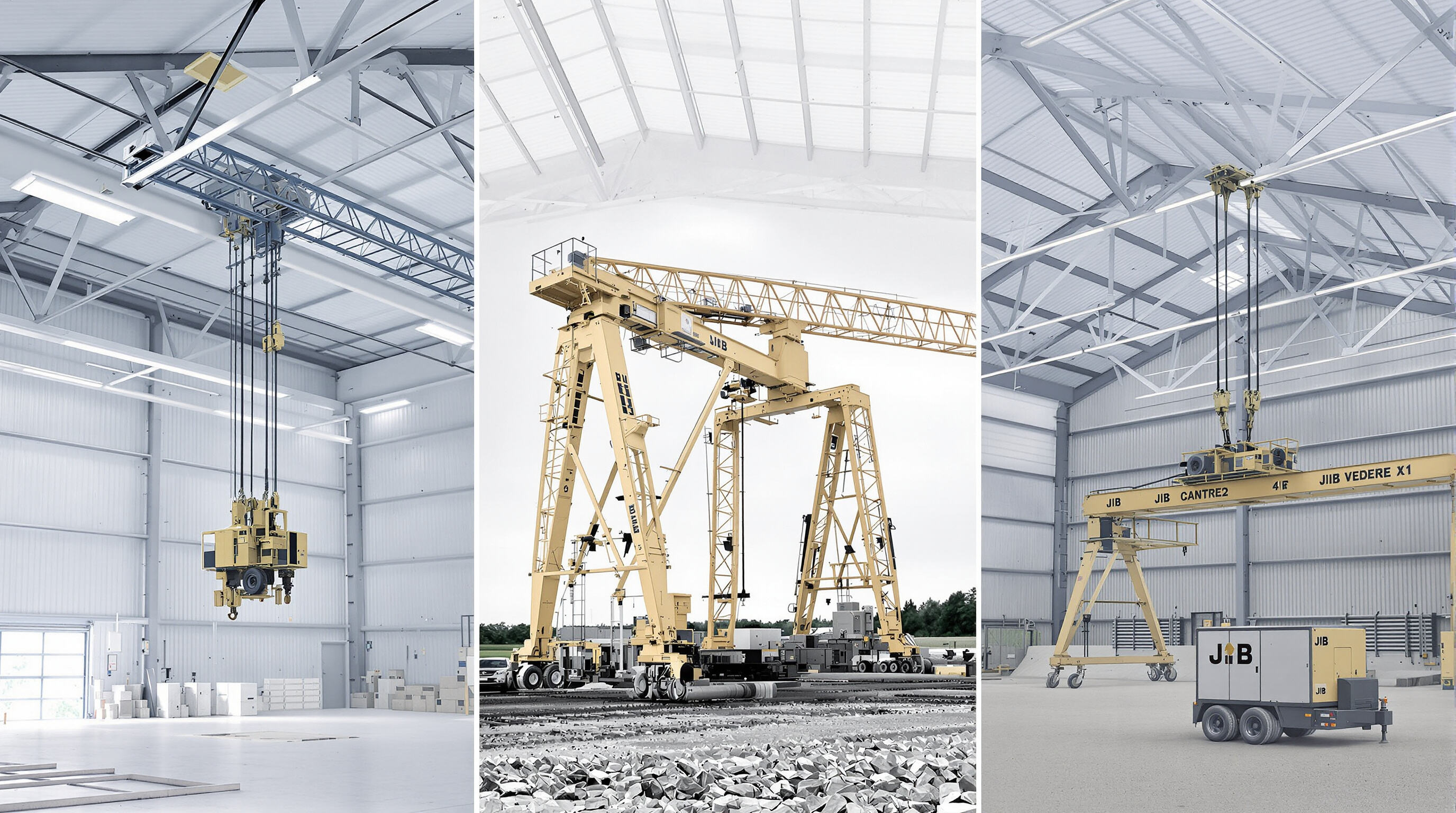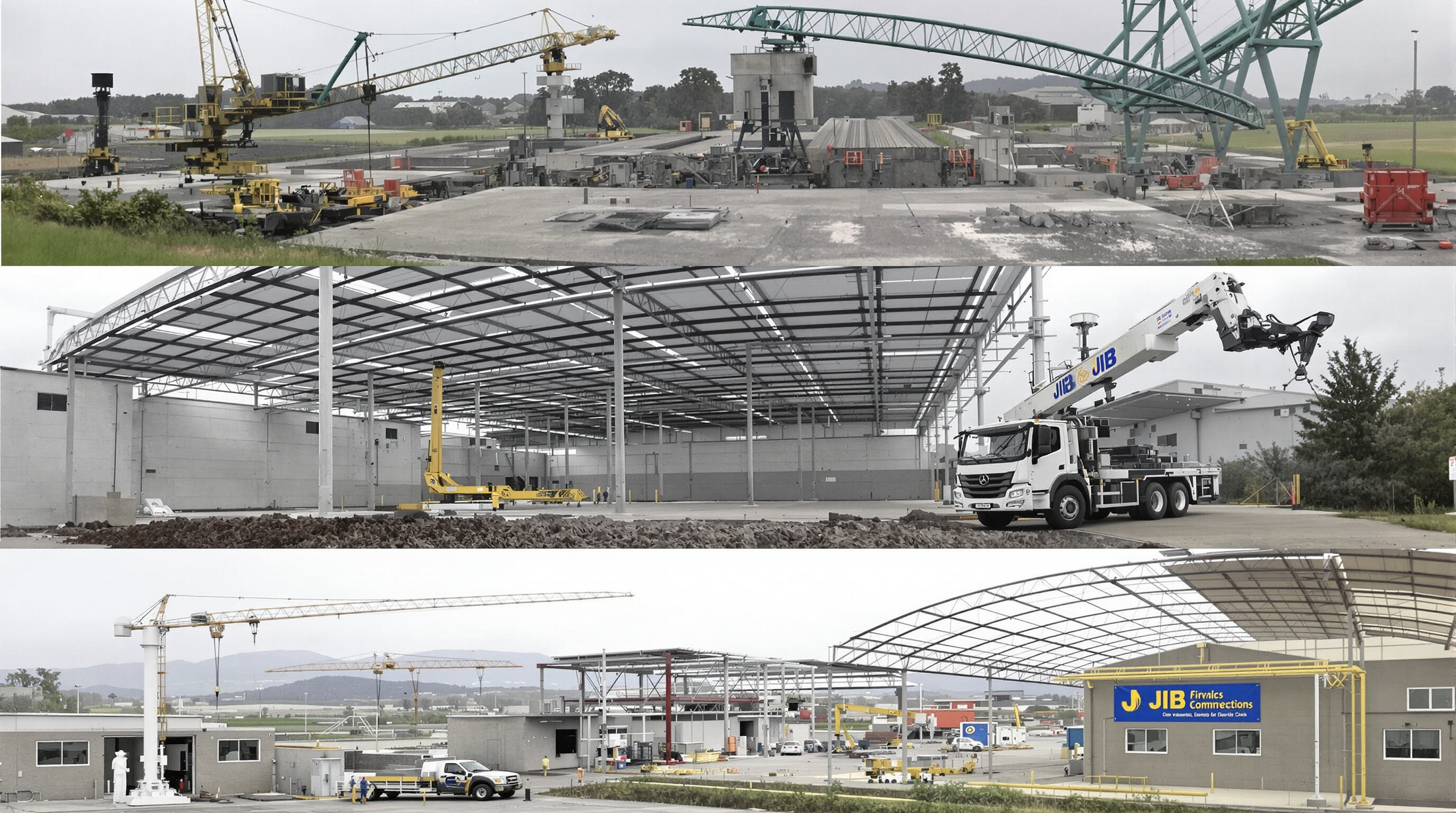Understanding Key Differences: Structure and Mobility of Overhead, Gantry, and JIB Cranes

Structural design principles: Overhead vs. gantry vs. JIB cranes
The overhead crane setup typically consists of a bridge connected to a trolley running along runway beams, which makes these cranes great choices for factories or warehouses with tall ceilings where long-term installation is needed. Gantry cranes take a different approach altogether. They have this sturdy A-frame structure mounted on wheels or tracks, so they can be placed outside without needing support from the actual building itself. That's why many construction sites prefer them. Then there are JIB cranes, which basically consist of a vertical pole attached to a horizontal arm that rotates around. These compact models save precious floor space at specific work areas like assembly stations or maintenance bays. The main difference between them all comes down to structural requirements. Overhead systems definitely need strong building reinforcements, while gantries stand on their own two feet literally speaking, and JIB cranes generally don't mess much with existing structures when installed properly.
Mobility and installation requirements across crane types
Installation complexity varies significantly:
- Overhead cranes demand reinforced steel runway beams (up to 25% of total project costs)
- Gantry systems require leveled surfaces but maintain portability between sites
- JIB cranes install in 1–2 days with either floor anchors or wall brackets
A 2023 MHIA study shows 68% of facilities choose JIB cranes for retrofit projects due to their low structural dependency, compared to 12% opting for overhead systems.
How facility layout influences crane selection
The right choice really depends on several factors including how high the ceilings are, what's on the floor getting in the way, and how things actually move around the space. Steel mills with those super tall ceilings (30 feet or more) tend to get the most out of overhead cranes since they can take advantage of all that vertical room. Shipyard operations need something different though. They typically go for gantry setups because these can cover those massive 100 foot plus distances across rough ground where traditional cranes wouldn't work well. Assembly areas face their own challenges too. Most lifting happens within about 20 feet radius in these spaces, so JIB systems become the solution when space is tight. Many lean manufacturing facilities mix and match different crane types depending on what makes sense for each area. The big production lines usually have overhead systems while smaller workstations might be equipped with JIB cranes instead.
Overhead Cranes: High-Capacity Lifting for Permanent Industrial Installations
Design components: Bridge, trolley, hoist, and runway systems
An overhead crane basically has a horizontal bridge sitting on those parallel runway beams, with a trolley and hoist moving back and forth along the bridge. Most facilities either build their runway systems right into the existing steel framework or install separate support columns, which lets operators move materials in both directions with precision. When it comes to heavy lifting in industrial settings, double girder cranes are the go-to choice for anything over 50 tons because they provide much better stability. For lighter workloads though, single girder models handle jobs with spans going up to around 30 meters pretty well. Safety is always a top concern too, so modern cranes come equipped with things like emergency stop brakes, load limit sensors, and backup drive systems that kick in if something goes wrong during operation.
Operational strengths: High load capacity and continuous duty cycles
Overhead cranes are built to handle tough industrial settings where they can lift massive weights, sometimes as much as 500 tons in places like steel mills and foundries. These machines run on enclosed tracks that let them work around the clock even when conditions get really rough, whether it's scorching heat or super corrosive air. What makes them stand out compared to those mobile crane options is that they don't block floorspace while still keeping things aligned pretty precisely, about plus or minus 3 millimeters. This kind of accuracy matters a lot when positioning huge molds or reactor vessels correctly.
Installation challenges: Building infrastructure and headroom needs
Implementing overhead cranes requires reinforced concrete foundations and steel support columns rated for dynamic loads. Facilities often need 25% greater headroom than the crane’s minimum operating height to accommodate maintenance access. Retrofitting existing buildings may demand structural upgrades costing $150–$300 per square foot, making early integration into facility designs cost-effective.
Ideal applications in steel mills and heavy manufacturing
In steel production facilities these cranes are absolutely essential for moving those heavy 20 ton ladles filled with molten metal at scorching temperatures around 1500 degrees Celsius. They also play a major role in automotive manufacturing where they handle massive 10 ton chassis parts during assembly. The design includes enclosed trolley systems which stop sparks from flying around dangerous areas prone to explosions. Plus their modular construction makes it really easy to hook them up with automated storage and retrieval systems found throughout today's smart factories. Manufacturers love this kind of flexibility when upgrading their operations.
Gantry Cranes: Flexible, Portable Solutions for Indoor and Outdoor Use
Types of gantry cranes: Full, semi, and portable configurations
There are basically three main types of gantry crane setups. First, we have the full gantry systems with those twin support legs running along both sides. Then there's the semi-gantry version which attaches to just one wall of the building. And finally, there are the portable units mounted on wheels or casters. These mobile options work great for temporary jobs where nobody wants to install permanent runways or dig deep foundations. According to some recent industry research, these portable models actually handle loads as heavy as 15 tons without compromising stability. They achieve this because they come with adjustable spans and height settings, so they fit nicely even in cramped workshop areas where space is at a premium.
Advantages in mobility and low structural dependency
Gantry systems work on their own without needing those heavy duty building supports that overhead cranes require, making them perfect for places that are rented out or used outdoors. The way these systems are put together in modules means they can be moved around pretty quickly too, sometimes within just about four hours flat. That kind of flexibility is really important when working on constantly changing operations such as managing cargo at shipyards or adjusting storage arrangements in warehouses that keep shifting their layout. Most people who run these operations care a lot about being able to move things around, which is why around three quarters of all operators place mobility high on their list of priorities. When it comes down to money matters, switching from traditional fixed setups to gantry solutions cuts down on infrastructure expenses by roughly two thirds according to industry data.
Applications in construction, warehousing, and temporary setups
These cranes really shine when things need to change quickly on site. Think about moving those big HVAC units around busy construction zones, shifting pallets all over storage areas, or getting into tight spots to service equipment in maintenance bays. The outdoor versions come with tough wheels that can tackle rough ground conditions, whereas the indoor models are designed specifically for spaces where headroom is limited, often below those standard 20 foot ceiling heights found in many warehouses. Around 4 out of every 10 manufacturing facilities have started using gantry systems for cross docking lately because they work just as well inside as outside, making them pretty versatile for different operational needs.
JIB Crane Systems: Space-Efficient Lifting for Localized Workstations
Free-standing vs. wall-mounted JIB cranes for confined spaces
When working in tight spaces, JIB cranes come in handy thanks to their two main setups: free standing ones and those mounted on walls. The free standing type gets bolted down to floors and can spin all around 360 degrees, making them great for places where multiple workstations need coverage, such as big machining areas or welding spots. For wall mounted versions, these are attached to building structures or walls themselves, giving about 180 to 200 degrees of movement. This helps save precious floor room especially in narrow passageways or between rows of machinery. According to research from the Material Handling Institute back in 2023, wall mounted cranes actually take up about 62% less space at workstations than their free standing counterparts when dealing with single cell operations. Makes sense why many shops prefer them nowadays.
Rotational range and lifting capacity considerations
The performance of JIB cranes really comes down to finding that sweet spot between how much they can rotate and what weight they need to handle. Most standard units work well for loads ranging from half a ton up to five tons. When dealing with heavier weights though, things get tricky. The foundation needs reinforcement or the rotation angle has to be cut back somehow. Articulating JIB cranes solve this problem by adding extra pivot points that let them maneuver around obstacles without dropping their cargo. These designs are especially handy in tight factory spaces where workers constantly run into problems. A recent survey found that nearly nine out of ten operators face some kind of obstruction when lifting items in crowded production areas.
Ideal use cases: CNC stations and assembly cells
These compact cranes thrive in repetitive material handling scenarios:
- CNC machine loading: Precision positioning of raw materials with ≤2mm variance
- Assembly cells: Ergonomic parts transfer between worktables without floor-based equipment
- Packaging lines: Continuous container maneuvering in areas with <3m ceiling clearances
Manufacturers implementing JIB systems in automotive assembly lines report 23% faster cycle times by eliminating manual cart transfers. The systems' modular design allows seamless integration with smart manufacturing setups through IoT-enabled load sensors and collision avoidance protocols.
Selection Criteria: Matching Crane Type to Application Requirements
Load Capacity, Span, Headroom, and Workflow Compatibility
When choosing industrial cranes, there are basically three things that matter most: how much weight needs to be lifted, how far across the workspace it has to travel, and how much vertical space is available. Overhead cranes tend to work best when heavy lifting is required - we're talking over 50 tons here, typically in facilities where runways stretch beyond 60 feet long. Gantry systems on the other hand handle outdoor jobs pretty well, usually dealing with loads between 10 to 30 tons and allowing for flexible span adjustments depending on what's needed. Then there's the JIB crane situation. These babies shine when space gets tight. Wall mounted versions take up only about an 8 foot by 8 foot area on the floor but still give workers around 200 degrees of rotation for lifting smaller items under 5 tons right at their workstations. According to recent research from the Material Handling Institute, nearly half (around 42%) of plant managers these days care a lot about maximizing headroom. That makes JIB systems particularly good fit for older warehouses being upgraded, especially those with ceilings only 10 to 15 feet high.
| Crane Type | Load Range | Span Flexibility | Minimum Headroom |
|---|---|---|---|
| Overhead | 1–500 tons | Fixed runway | 18–24 feet |
| Gantry | 1–100 tons | Adjustable legs | 12–20 feet |
| JIB | 0.25–10 tons | 180–360° pivot | 8–12 feet |
Total Cost of Ownership: Installation, Maintenance, and Scalability

Overhead cranes typically need structural upgrades costing anywhere from fifty to two hundred thousand dollars for runway installation, but most last over thirty years so they make sense for factories running around the clock. Portable gantry cranes cut first costs by roughly sixty to seventy percent, which is great for budgets, though they do require about eighteen percent more maintenance each year because they're exposed to the elements outside. JIB systems offer something in between these extremes. These free standing units can be installed within just under two days at a total expense ranging between fifteen and forty thousand dollars. What really stands out is their low maintenance requirements, usually below five percent annually. That makes JIB systems particularly attractive for smaller production areas where companies handle batches rather than continuous operations.
Comparative Use Cases: When to Choose Overhead, Gantry, or JIB Crane
- Overhead: Continuous coil handling in steel mills requiring mill-duty (FEM M8) cycles
- Gantry: Shipyard plate flipping needing 80“ outdoor reach and reconfigurable tracks
-
JIB Crane: CNC machine tending with <3-ton tools and 270° rotation in compact work cells
Aerospace manufacturers report 31% faster turbine assembly using JIB cranes versus manual lifting—the localized precision reduces part reorientation time by 58%.
FAQ Section
What are the main types of cranes discussed in the article?
The main types of cranes discussed are overhead cranes, gantry cranes, and JIB cranes.
Which crane type is ideal for high-capacity lifting in industrial settings?
Overhead cranes are ideal for high-capacity lifting in industrial settings as they can handle heavy weights up to 500 tons.
Why are gantry cranes favored for outdoor setups?
Gantry cranes are favored for outdoor setups due to their mobility, portability, and low structural dependency.
When should a facility consider using JIB cranes?
Facilities should consider using JIB cranes when dealing with tight spaces and needing localized lifting solutions at workstations.
What factors influence the choice of crane types for a facility?
Factors such as load capacity, span flexibility, headroom, and workflow compatibility influence the choice of crane types for a facility.
Table of Contents
- Understanding Key Differences: Structure and Mobility of Overhead, Gantry, and JIB Cranes
- Overhead Cranes: High-Capacity Lifting for Permanent Industrial Installations
- Gantry Cranes: Flexible, Portable Solutions for Indoor and Outdoor Use
- JIB Crane Systems: Space-Efficient Lifting for Localized Workstations
- Selection Criteria: Matching Crane Type to Application Requirements
- Load Capacity, Span, Headroom, and Workflow Compatibility
- Total Cost of Ownership: Installation, Maintenance, and Scalability
- Comparative Use Cases: When to Choose Overhead, Gantry, or JIB Crane
-
FAQ Section
- What are the main types of cranes discussed in the article?
- Which crane type is ideal for high-capacity lifting in industrial settings?
- Why are gantry cranes favored for outdoor setups?
- When should a facility consider using JIB cranes?
- What factors influence the choice of crane types for a facility?

